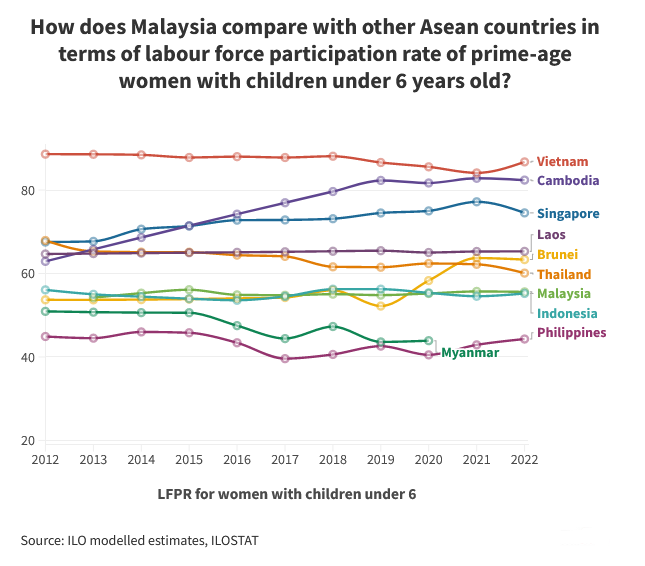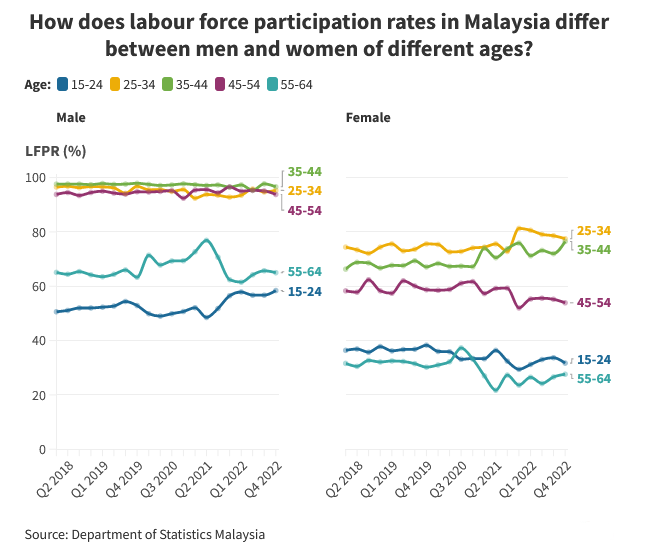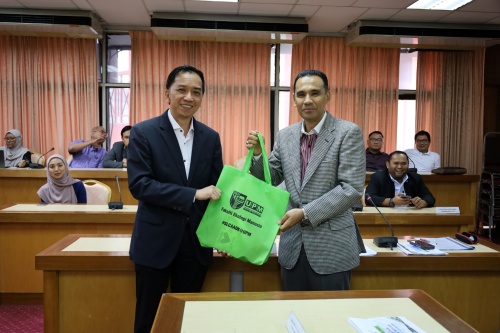|

Caption: Bibi Zulaikha Misbahul Munir, a 31 year old entrepreneur with two children who works from home.
PETALING JAYA: Many working mothers are struggling to find and retain jobs because too few workplaces offer flexible hours and work-life balance.
According to the International Labour Organisation (ILO), this affects women in many countries including Malaysia.
According to the ILO, the labour force participation of working mothers in Malaysia is the fourth lowest among Asean’s 10 member countries.
Only 55.59% of prime-age women with children under the age of six in Malaysia are working, compared with 86.74% in Vietnam, which is the highest in Asean (see chart).

Universiti Kebangsaan Malaysia's Critical Media Studies Assoc Prof Dr Jamaluddin Aziz said the main problem affecting the labour force participation of working mothers in the country is their difficulty finding work that offers adequate support, especially in the form of flexible hours and work-life balance.
“This factor depends on the nature of the work and the support a working mother gets from her family and workplace.
“Usually, women who have a supportive husband and/ or employer will struggle less,” he said.
Amid Malaysia’s current economic challenges, working mothers will find it harder to find or retain work due to an employer’s expectations, Jamaluddin said.
He said some employers are biased against hiring women, whom they feel will need more time away from work for maternity leave and other family matters.
He said some employers with outdated notions of gender roles may prefer to hire men whom they feel should be the family breadwinners.

Jamaluddin said working mothers face many struggles juggling work and care responsibilities.
The most common, he said, is in trying to strike a balance between family and work.
“This struggle will be more prominent if they have kids with special needs or elderly parents to care for at home,” he added.
Working mothers also face difficulties in dealing with societal and workplace expectations.
“Even the phrase ‘working mother’ is problematic. Being a mother is already full-time job.
“This notion, which implies that only a mother who is employed is doing work, must be contested.
He said some people wrongly expect women to be all-rounders who are supposed to be the main family caregiver while contributing to the family financially.
Jamaluddin said some working women also face workplace discrimination in the form of severe wage and hiring disadvantages.
“This phenomenon, which is called the ‘motherhood penalty,’ makes it harder for working mothers to rise to decision-making positions.
“Working mothers are normally stuck at the same position, which does not liberate them,” he said.
Jamaluddin said that although some husbands are now more involved in child rearing, a woman’s work arrangement and the expectations placed on them is still often disadvantaged when compared with men.
He said working mothers need better employment conditions such as paid parental leave, flexible working hours, easy access to quality childcare, and laws and policies that prohibit discrimination and which support family units.
“However, we still see the same issues recurring even after numerous policies are formulated and announced,” he added.
Greater political will and better coordination among ministries are needed for such policies to be effective.
“More aggressive, cohesive and coordinated efforts and initiatives must be taken among ministries and government agencies, with the main coordinator being the Prime Minister’s Office.
“Without strong and clear inclusive policies, a consistent dissemination of information, strategic family planning education, gender-responsive budgeting, and systematic monitoring and enforcement procedures in place, employers will continue to find it easy to hoodwink vulnerable working mothers,” said Jamaluddin.
Prof Dr Rumaya Juhari of the Department of Human Development and Family Studies and Faculty of Human Ecology, Universiti Putra Malaysia, said working women across the globe face tremendous pressure coping with work and family demands.
“Women take on multiple roles combining responsibilities within the family as well as at work.
“Working mothers do more house chores and childcare while at the same time work for money, while men counterparts also work for money but do rather fewer house chores or less childcare,” she said.
She said these factors cause women to be more likely to take time off work than men, which may affect their employment prospects.
“Their lower salary can also cause women to quit their job to dedicate their time to care responsibilities.”
Prof Rumaya said workplaces are often designed around traditional male employment patterns, with long hours, rigid work schedules, and little flexibility.
She said there needs to be more provision to support working mothers, such as providing flexible working hours, hybrid work arrangements which alternates between working from home and working at the office, extended maternity leave, and promoting a father-friendly work environment.
“Another important support is by providing good quality and affordable childcare centres or daycare for the elderly at or near workplaces,” she said.
She said there needs to be a major paradigm shift that acknowledges the need to support working mothers in fulfilling their duties.
“Husbands also need to be more supportive; more involved and mindful. They must take up the roles and responsibilities on home affairs and childcare as part of their tasks and not merely do it to ‘help’ the wife,” she added.
According to the ILO, the gender gap in labour force participation among people aged 25 to 54 stood at 29.2 percentage points in 2022, with female participation at 61.4% and male participation at 90.6%.

“This large difference cannot be explained solely by women’s greater difficulty in finding jobs. Recently updated data suggests that a major factor lowering women’s labour force participation globally is child-rearing,” the ILO said.
It noted that for workers between the age of 25 and 54 with at least one child under six, the labour force participation gap widens from 29.2 to 42.6 percentage points, with female participation at 53.1% and male participation at 95.7%.
“Mothers of young children are less likely to participate in the labour market than their peers, which is called the ‘motherhood penalty,’ while fathers experience higher participation rates, a ‘paternity premium.’
“Although women’s participation is reduced by the presence of young children across all income levels, there are large variations in the motherhood penalty across income groups,” it said.
Recent ILO data revealed that the highest motherhood penalty ratio of 19.8% is observed in upper-middle-income countries, meaning that mothers participate almost 20% less than the average among those age 25-54.
The penalty in high-income countries is 13.2%.
The lowest ratios are observed in lower-middle-income countries at 4.3%, followed by low-income countries at 5.4%.
Online Source: The Star
|

















.png)

















